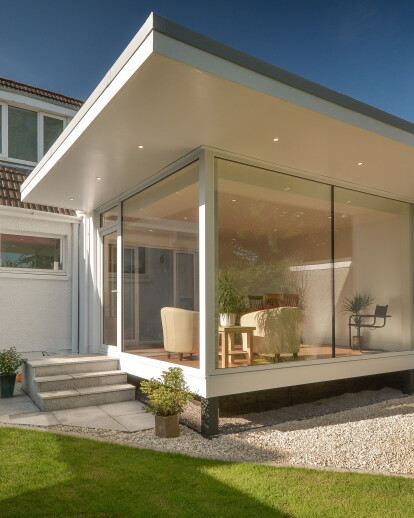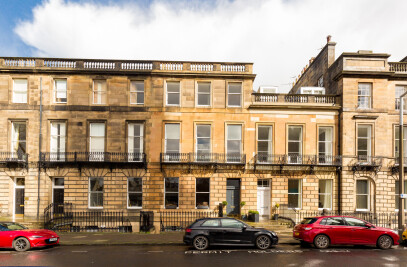There was a recent article in Building Design magazine which drew a contrast between the fashion industry and the Architectural profession. The magazine is only available to subscribers but the article goes like this; The fashion industry has worked hard over time to offer well designed goods to suit every budget, but contemporary Architecture is still so expensive that it remains the preserve of an elite minority. As the cost of fashionable clothes have fallen over recent decades, so more people have been able to afford them. If Architects could reduce construction costs, then more people would commission contemporary Architecture and everyone would benifit.
There is a degree of truth to this but also some dishonesty, for example the construction industry cannot easily outsource its building work to low wage economies. That being said, the article was timely for me because I was completing my own experiment in low cost / high quality Architecture when it was published.
I had been asked by a client in Edinburgh, who was improving her garden, to design a room to compliment the new landscape. This was not an unusual request but the brief was exceptional. The client wanted an elegant, contemporary garden room of at least 20 square meters, with as much glass as possible, for well under £30k. This was a serious challenge but also an opportunity to try something different. If we used the normal construction method of timber frame with masonry walls and tile roof, the cost would easily be £35k, or more, for a building that size. Using that technology, It could also struggle to be either elegant or contemporary.
Before she retired the client worked for a structural engineering firm, so she had a good grasp of the construction industry and appreciated my concerns. She also had a well developed aesthetic sensibility and during our discussion we got round to talking about mid 20th century modern Architecture. Then the solution hit me, a simple steel frame would solve both problems; it could be affordable and elegant.
The concept evolved several times and required a surprising amount of drawing and specification for such a small building.
The final design is simple but sophisticated, a square room, 4.5m wide with two walls of glass providing an uninterrupted view of the garden, like massive HD televisions. The roof overhang works several ways; drawing the eye down, towards the garden and away from the sky, when viewed from inside. By providing a sheltered, intermediate zone on the outside, it also caps off the garden room, making it appear larger, framing an elegant, horizontal proportion.
The big news is that the garden room cost just £27k, including VAT. In terms of value, it is extraordinary. While £27,000 is a large sum, in relative terms it is like getting a Rolls Royce for Mondeo money. So how does it work, why is it cheaper than a conventional building of the same size?
Steel and glass are expensive materials to buy, far more than timber, brick, blocks, roof tiles etc. But if steel and glass are designed correctly, they can have one huge advantage. Speed.
The entire steel frame was built in one day and the glass was installed in one afternoon.
Because the garden room is supported on four steel posts it only needs four modest foundation pads. If it had been built using conventional methods, the foundations would be massive by comparison, extending under the entire perimeter wall. Building using steel frame allowed the foundations to take less time and use less material. Conventional foundations usually cost about 20 - 25% of the overalls budget, these ones cost just 10%.
Finally, by reducing the number of materials we also reduced the number of tradesmen required. A conventional building, using timber frame construction, will need a joiner to build the frame, a brickie to build the outer masonry wall, a plasterer to render the outside and a decorator to finish the inside. If the wall is made entirely from glass however, it just needs a fitter to install it. Job done. This requires less coordination and management by the builder, further reducing the costs.
While I could go on at length about the Architectural qualities of this design; it's simple minimalist aesthetic, elegant proportions, the use of form, space and light etc, I think the photographs speak for themselves.
Instead I am far more excited about its economic relevance. The ability to have a sizeable, well insulated living space that is beautiful and contemporary for sub £30k is, to the best of my knowledge, unavailable at present. Until now people who need the space but cant afford the building costs have one option; a cheap conservatory. Even for those who could afford a typical house extension, there is a hidden factor which Architects seldom discuss. House prices.
It goes like this, if you own a three bedroom suburban house in a nice part of Edinburgh it might be worth £250k or £300k so spending £75,000 on an extension is a reasonable proposition. If you own the same house in Dunfermline or Livingston however, it is probably worth £150k to £180k so spending £75k on an extension is less appealing because that is half the value of the house! Even if they have the money, most people in these areas will use it to buy a bigger house rather than extend what they have.
In the year since I moved to Fife most of the house extensions I notice are unremarkable, one room, one storey boxes with small UPVC windows and lean-to roofs. Builders tell me that theses are commonplace in Glenrothes, Dunfermline and Kirkcaldy and they typically cost under £30k. Apparently these designs are the preserve of draftsmen and plan-drawers, with Architects almost totally absent from this segment of the market.
This is exactly the situation described in the BD article, with whole areas of the country and sections of the home owning public for whom contemporary Architecture is inaccessible, despite the fact they can afford to carry out building work!
In the past, everyone wore clothes but only the wealthy could afford fashion. Today, thanks to globalisation, most people in our society can buy clothes designed and made to a standard that was elite just two generations ago.

































